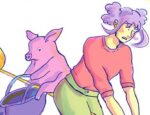This enlightening little book offers some interesting thoughts on an increasingly visible strand of comics work, and presents a selection of fresh and stimulating work that isn’t afraid to step beyond formal barriers.
 As Chrissy Williams and Tom Humberstone, the editors of Over the Line, identify in their introduction, comics and poetry both have a bit of an image problem, albeit at opposite ends of the perceived cultural spectrum.
As Chrissy Williams and Tom Humberstone, the editors of Over the Line, identify in their introduction, comics and poetry both have a bit of an image problem, albeit at opposite ends of the perceived cultural spectrum.
To a wide section of the general public, comics are a childish diversion for the semi-literate, while poetry is the dead-white-guy stuff you had to plough through at school while waiting to do something altogether more exciting.
However, the two forms actually have a lot in common, both aesthetically, in their ability to step beyond naturalism, and culturally, in terms of being a marginal form, fuelled by large part by independent small-press activity. And, like the outcast high-school kids in an ‘80s film, strange and wonderful things can happen when they get together.
Indeed, while ‘poetry comics’ have been with us for decades now, the style seems to be gaining particular attention at the moment, through periodicals such as Ink Brick and events like a recent exhibition at the Poetry Library in London’s South Bank Centre – the epicentre of the capital’s cultural life.
L-R: Extracts from ‘Protoliths’ by Emix Regulus, ‘Meredith’ by Trinidad Escobar and ‘Triborough Bridge’ by Alexander Rothman
Williams and Humberstone describe their book as a “playful introductory exploration”, and it mercifully steers clear of the spirit-sapping turgidity of much ‘comics scholarship’. Instead, it takes a much more open-ended approach, using a clear structure to examine the past, present and possible future of the style. As professed by its editors, this is a launch pad rather than a comprehensive survey.
The book’s first section – ‘Some introductions’ – offers a useful primer in how we can draw parallels between the two forms and how something called ‘poetry comics’ might work. The editors use Scott McCloud’s categories of panel transition as a starting point, from the simple, linear ‘moment-to-moment’ transitions to the ‘aspect-to-aspect’ and ‘non-sequiteur’ devices that lend themselves naturally to the poetic imagination.
What the strongest poetry comics highlight most effectively is the ability of visual imagery to embody complex emotional or aesthetic statements. It has often been observed that whenever we put two images (or images and words) next to each other, we can’t help but try to form a connection between them.
L-R: Extracts from ‘Sea of Faces’ by Anna Saunders, ‘Ding Dong’ by Jenny Robins and ‘Thru a Pinhole’ by Lala Albert
Apologies in advance for my hamfisted cultural appropriation, but it seems to me that the best works in this idiom act like a koan – a little paradox or riddle that’s used to train Zen Buddhist monks to approach questions intuitively rather than analytically.
In poetry comics, this takes the form of a disconnection between the images (or between words and image) that creates a moment of uncertainty in the reader – a gap the brain has to fill with its own connection, drawn from the individual’s perception and experience.
The editors then probe a little further, suggesting parallels between the construction of a comics page and a poem (and hinting – slightly contentiously – that most of the creative choices only take place during the physical creation of the page, after the script has been written).
In a looser style, we’re also presented with a few ‘Oblique Strategies’-style statements to consider when looking at work in the two mediums, from ‘Consider how much will fit on the page’ to ‘All the right notes, not necessarily in the right order’.
Finally in the opening section, a ‘Practitioners’ section includes excerpts from some of the field’s pioneers, including Bianca Stone, Paul K Tunis, Derik Badman, Julie Delporte and Louise Crosby and Clare Shaw.
L-R: Extracts from ‘Nightbus’ by Tim Bird and ‘Reading Ourselves’ by Nicolas Labarre
The bulk of the book (over 70 pages) is taken up with the ‘New work’ section, covering a wide range of style and approaches – so varied, in fact, that it’s hard to recap in generalities. Some take a more well-worn path of illustrations backing up more overtly ‘poetic’ text, while others employ a more formalist approach, using page layouts and echoing imagery to evoke the effects of metre and rhyme.
They go from discordant, seemingly spontaneous cut-ups to comics that don’t really look much different from the narrative pieces you may find in any number of small-press anthologies. In fact, the formal boundaries that seem clear in the text section of the book become a lot more elusive in the main body of work.
But any vagueness of definition or imperfect mapping of poetic jargon onto comics don’t represent any kind of failure on the editors’ part. In fact, they highlight that poetry comics are a form at an exciting developmental stage.
As much as anything, Over the Line should connect with artists who might be thinking that their work doesn’t look like they think comics ‘should’ look. And that throwing open of comics culture to new voices is something to be roundly welcomed.
Various (W/A), Chrissy Williams and Tom Humberstone (Ed) • Sidekick Books, £15























